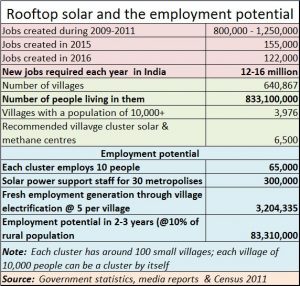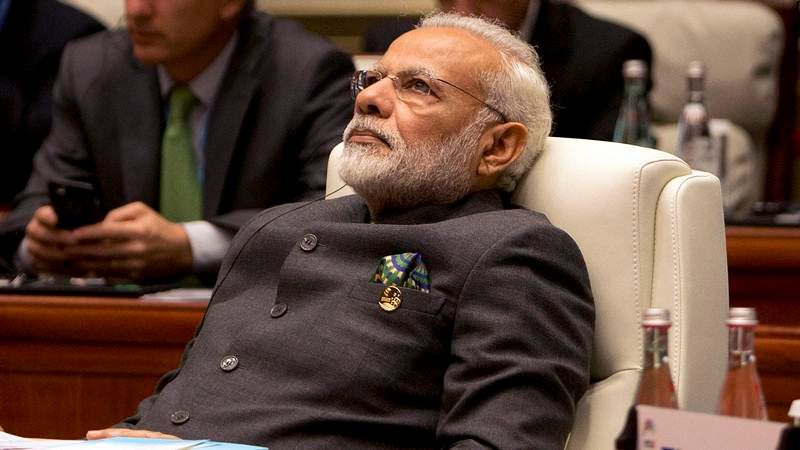http://www.freepressjournal.in/analysis/look-up-mr-modi-the-sun-is-shining/1152421
Rooftop solar can help create around 83 million jobs
— By | Oct 12, 2017 07:56 am
Mr. Modi’s biggest headache is creating jobs. Look at the table alongside. During 2015 and 2016, India created just 277,000 jobs. This was lower than the number of jobs created in 2009-11. True, all the blame cannot be put at the government’s doorstep. There was an economic slowdown already underway. It only got exacerbated by demonetisation, the rushed introduction of GST and a few other oversights.
However, the job of any government is to overcome odds and create jobs. And there is no better model to study at such times than the one Germany adopted. When the late Hermann Scheer (energy minister of Germany in 2000) decided to push for solar power in his country, he had two strategies (http://www.asiaconverge.com/2016/04/india-not-learn-germanys-hermann-scheer-solar-power-model/).
 First, he was convinced (he was an electrical engineer who had studied his numbers carefully) that if solar were to be given just 1% of the subsidy that the oil industry had enjoyed, he could make the whole world look to solar as the source of energy. He was also buoyed by the knowledge at in the Sahara, just 6 hours of sunlight produces enough energy to light up the whole world for a full year.
First, he was convinced (he was an electrical engineer who had studied his numbers carefully) that if solar were to be given just 1% of the subsidy that the oil industry had enjoyed, he could make the whole world look to solar as the source of energy. He was also buoyed by the knowledge at in the Sahara, just 6 hours of sunlight produces enough energy to light up the whole world for a full year.
There was a second strategy in place — to create a middle layer of solar entrepreneurs. This layer would set up the solar panels on houses (with state funding), maintain it (clean it regularly, for better absorption of sunlight, and also attend to any problems). The entrepreneur would also collect solar power from rooftop solar paneled houses at a pre-determined price (which came to be known as the feed-in-tariff or FIT and which got adopted the world over subsequently). He thus aggregated the minuscule solar power outputs from each solar rooftop household, cleaned it up, and supplied a steady stream to the national power grid.
Within a decade, his dream was to come true. Bolstered by the German model, and the consequent demand, China stepped in with its large scale production. Other countries stepped in with innovation. Together they saw the price of solar power drop from almost 20 cents a unit to less than 3 cents. The dropping prices of solar panels and the sharply drop in battery storage prices (http://www.asiaconverge.com/2015/06/battery-a-dirge-for-fossil-fuels/) has made solar power a mighty competitor to the convention power grid (notwithstanding what the economic survey tries to say – http://www.asiaconverge.com/2017/09/the-economic-survey-is-wrong-about-renewables/).
Most important is a lesson that India must appreciate. In less than a decade, the solar power industry in Germany employed more people than even the automobile sector. The middle layer of entrepreneurs was creating employment opportunities that had not been envisaged before. Now Germany has less sunlight, and fewer people than India. So, obviously, India, with more people (hence houses) and more sunlight, should be having more rooftop solar units. That should make the middle layer more profitable and vibrant. It could be an excellent solution to India’s need to create jobs.
Of course, the prime minister will have to keep at bay the lobbies which support the conventional power grid. Villages that are covered by this model (read more about how to create decentralised clusters at http://www.asiaconverge.com/2017/09/radical-power-solution-government-should-adopt/) must be cut off from the power grid. With batteries that guarantee standby power for 48-72 hours, there is no need to have the grid as a standby. The grid now does not need to subsidise agriculture.
By dispensing with long supply lines to villages, transmission losses (and theft) also get curtailed. That will allow grids to give power to industry at Rs.5-6 per unit because there will be little need for cross-subsidy. The lower tariffs for industry and commerce (compared to tariffs of Rs.8-14 at present) will make them more competitive. That should make the wheels of commerce move faster. The prime minister will have created the right mood for employment and growth, without subsidies.
To make the decentralised cluster rooftop model politically attractive, the government can also offer the first 200 units free of power to each household. But the success of this model also depends on each cluster being managed and developed by private entrepreneurs (not by arms of the government). The private entrepreneur gets his money from the banks for financing this cluster rooftop solar module. The bank gets it refinanced by an arm of the government which merely capitalises the subsidies and losses related to each village cluster. The capitalised subsidies and losses then get bundled as an asset to be backed by bonds floated and guaranteed by the government. This bond issuing company will then play the same refinancing role for the rural power sector that Nabard does for agriculture.
Since the entrepreneur has to make money from families that use more than 200 units, he also plays the role of catalyst to promote small business enterprises in the cluster. If the commercial venture is successful, the farmer makes money, but so does the entrepreneur. As a businessman, he keeps a sharp lookout for families which try to beat the system by creating more households within the same family (this is what has happened with slums in India http://www.asiaconverge.com/2014/03/caste-politics-of-slums-their-effects-on-cities/).
The results could be electrifying (no pun intended). Each cluster could create jobs for at least 10 people. Large villages with populations of over 10,000 (there are 3,976 such villages) could be treated as independent clusters. That alone should create over 65,000 jobs within 8 months (maybe even six). Business development in villages could see some additional jobs getting created. In 2-3 years, you could end up creating 83 million jobs and self employed people in the rural areas. Then work on cities with dense populations, where both roofs and walls could be enabled with solar panels. The potential is mind-boggling.
What is equally important is that the more one uses solar, the less does one need to import oil and coal. Kerala’s experimentation with solar boats is a great example to bear in mind. Operational costs drop to less than 10%, and there is little smog created over the backwaters.
Add to this methane digestors (http://www.asiaconverge.com/2016/07/solar-methane-better-days-ahead/) – but more on that later. If executed well, the prime minister could have an unbelievable story to tell – not just to Indians but to the entire world.





































COMMENTS